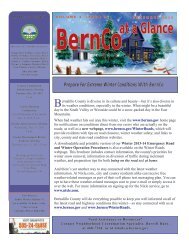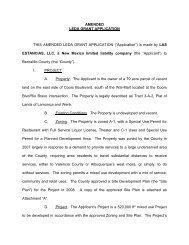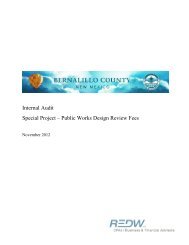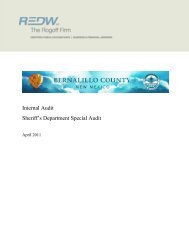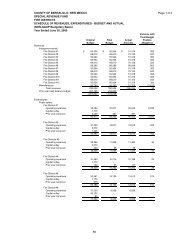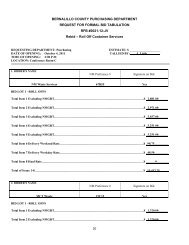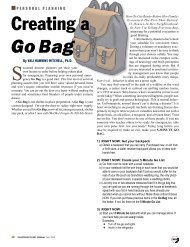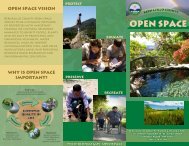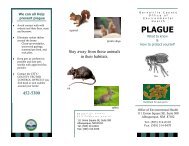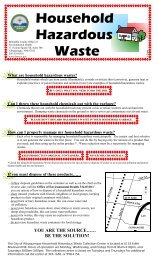Water Quality Protection Policy and Action Plan - Bernalillo County
Water Quality Protection Policy and Action Plan - Bernalillo County
Water Quality Protection Policy and Action Plan - Bernalillo County
- No tags were found...
Create successful ePaper yourself
Turn your PDF publications into a flip-book with our unique Google optimized e-Paper software.
<strong>Water</strong> <strong>Quality</strong> <strong>Protection</strong> <strong>Policy</strong> <strong>and</strong> <strong>Action</strong> <strong>Plan</strong>information about the quality of water in the Rio Gr<strong>and</strong>e; however, the data should beinterpreted carefully. The number, timing, <strong>and</strong> frequency of samples collected vary dependingon the purpose <strong>and</strong> goal of the particular agency <strong>and</strong> the specific monitoring event. In additionto these factors, there are many other variables—such as the sampling method (grab samplefrom the bank, discharge weighted sample, composite samples), parameters analyzed for,analytical methods, <strong>and</strong> reporting limits—that can make it difficult to compare data collected byvarious agencies.Some considerations for design of an effective monitoring program include: In order to adequately characterize the seasonal variation in the water quality of aparticular reach of a river, samples must be collected in each season throughout theyear.Because water quality conditions of a river may vary during wet conditions versus dryconditions, sufficient samples must be collected during various flow regimes.Stormwater discharge can have substantial effects on water quality of the Rio Gr<strong>and</strong>e;therefore, samples must be collected during stormwater runoff events. In order to evaluate temporal trends in water quality conditions, samples must becollected over a sufficiently long period of time.Among the more useful of these programs in establishing ambient water quality conditions ofthe Rio Gr<strong>and</strong>e are several investigations conducted by the USGS. In particular, a basin-wideinvestigation of the Rio Gr<strong>and</strong>e above Albuquerque conducted from 1992 to 1995 as part of theUSGS NAWQA involved sampling surface water at least monthly at multiple sites near theMRG-A reach of the Rio Gr<strong>and</strong>e; these data are useful to characterize ambient water qualityduring various streamflow regimes for multiple points in the watershed upstream from the intaketo the WUA WTP. Data collected during the 1992-95 period were analyzed <strong>and</strong> presented byAnderholm et al. (1995), Healy (1997), Levings et al. (1998), <strong>and</strong> Moore <strong>and</strong> Anderholm (2002)<strong>and</strong> can be used to characterize ambient conditions during the 1992-95 time period.A recently published USGS report summarizes seasonal <strong>and</strong> spatial trends in water quality <strong>and</strong>streamflow for the portion of the Rio Gr<strong>and</strong>e watershed upstream from the MRG-A reach from1985 to 2002 (Langman <strong>and</strong> Nolan, 2005). In that report, the site closest to the WUA WTPintake is USGS Station Number 08330000, the Rio Gr<strong>and</strong>e at Albuquerque, which is located atthe Central Avenue bridge. The period of study included both above-average rainfall conditions(1978 to 1992) <strong>and</strong> drought conditions (1999 to 2002); therefore, the data set represents a12 Section 2



